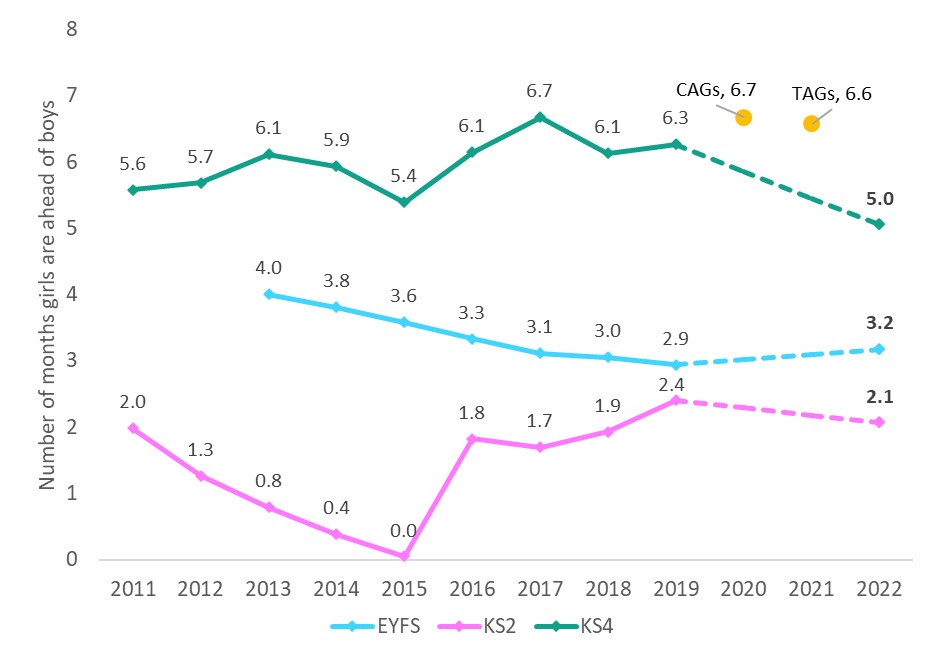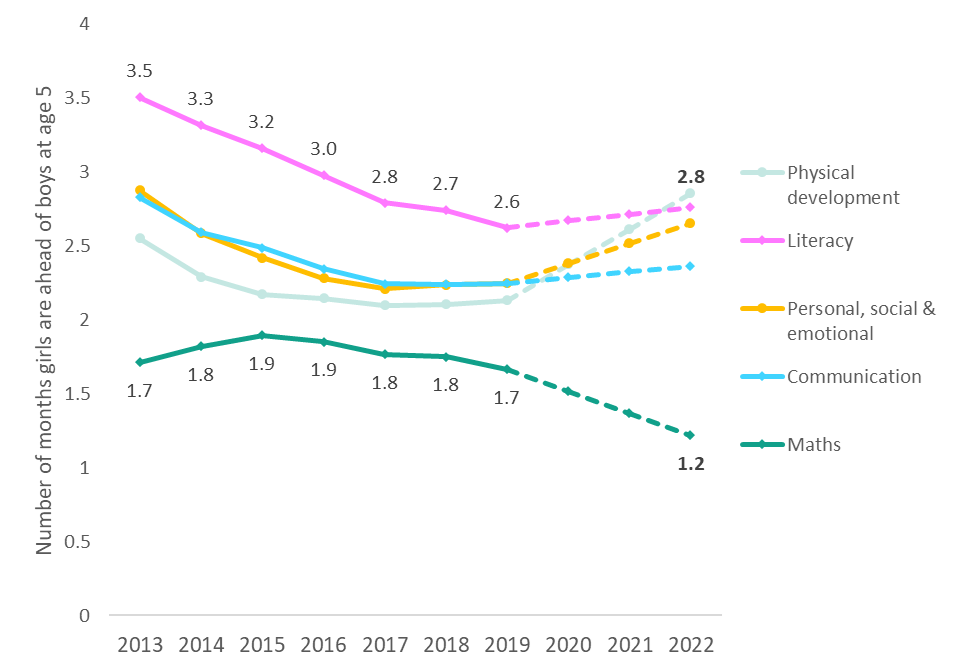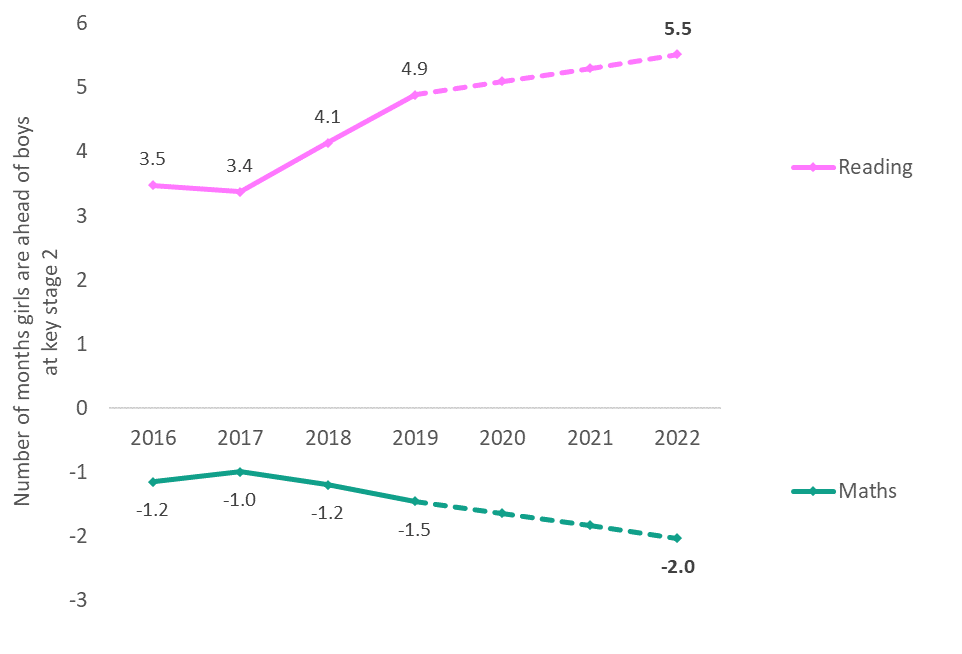Gender
Early years foundation stage
Historically, girls have outperformed boys across education phases. The gap among pupils aged 5 is already quite marked: girls were 3.2 months ahead of boys in 2022. The gender gap increased in 2022 (from 2.9 months in 2019), reversing the gap-narrowing trend from 2013 to 2019. Nevertheless, the difference between boys and girls in 2022 has diminished since the start of our series in 2013 by almost one month.
Figure G1: The gender gap has been on a long-term downward trend for pupils in reception and more erratic for older pupils, though it has narrowed at both key stages 2 and 4 since 2019

Primary school
By the end of primary school, the gender gap has shrunk compared to reception year – in 2022, boys were 2.1 months behind girls. This is a smaller gap than in 2019 (of 2.4 months) and similar to the 2011 gap (of 2.0 months). Following a period of gap-narrowing until 2015, girls have once again established a clear lead over boys. This lead was established in 2016 – the first year which assessed the new, more challenging national curriculum introduced in 2014.
Secondary school
Whilst the gender gap – unlike the gaps for disadvantaged pupils and other vulnerable groups – reduces as children progress through primary school, it widens again during secondary school. In 2022, boys were 5.0 months behind girls averaged across GCSE English and maths. This is over one month smaller than the 6.3 month gap recorded in 2019 and marks the smallest gender gap since the start of the series in 2011 (when it was 5.6 months).
Exploring gender gaps in more depth
To get a better understanding of the gender gap at each key stage, we split the headline gap into its constituent scores for individual subjects or areas of learning. We find that across school phases, the headline gap is masking important variation by subject, with boys consistently having a narrower gap – or even outperforming girls – in maths compared to the gap in English. The secondary school phase is when boys appear to particularly lose ground to girls.
Early years foundation stage – by area of learning
At the early years foundation stage, the headline gap aggregates across the five areas of learning that comprise the Department for Education’s ‘good level of development’ measure. Figure G2 shows that girls consistently outperform boys in each of these five areas. Historically, this has been most marked for literacy and least marked for maths and across areas, gaps were generally declining over the pre-pandemic period.
In 2022 we see divergent patterns between maths and the other areas. The maths gap narrowed to 1.2 months in 2022 – its lowest since the start of the series in 2013 – whilst the gap for all other areas widened, reaching 2.8 months in literacy.
Figure G2: Girls outperform boys across all areas of learning at age 5, with the biggest gap for physical development, followed by literacy, and the smallest gap in maths

Although our gap methodology is slightly different to the official EYFSP data, the latter provides further insights into where boys are falling furthest behind. The official data confirms the biggest gender gap in 2022 was for physical development and within this, boys were furthest behind girls in fine motor skills. Within literacy, boys lagged behind most in writing and within personal, social and emotional development, the gender gap was biggest for self-regulation.
Primary school – by subject
For key stage 2, we split the headline gap into its constituent parts of maths and reading. Given the major reforms to key stage 2 assessments in 2016, we use this as our starting point for a more in-depth analysis. As with attainment at age 5, it is clear in Figure G3 that the performance of boys and girls is subject-dependent. Girls outperform boys in reading (by 5.5 months in 2022) and boys outperform girls in maths (by 2.0 months) – and in both cases, the gender gaps have widened over the period 2017 to 2022. Notably the gender gap in maths reverses between the ages of 5 and 11, such that boys overtake girls at some point during primary school.
Figure G3: Girls outperform boys at reading at age 11 but at some point during primary school boys overtake girls in maths

The official key stage 2 attainment data looking across a wider range of subject areas confirms girls outperformed boys in all subjects in 2022 except for maths, where boys performed better than girls at both the expected and higher standard. The biggest gender gap was in writing (in favour of girls), indicating this is an area where some boys struggle at both the start and end of primary school.
Secondary school – by subject
For key stage 4, we split the headline gap into GCSE maths and English for our more in-depth analysis and use 2017 as the starting point, given this is the year that the newly reformed GCSEs were introduced. Figure G4 shows that by the end of secondary school, girls were 9.6 months ahead in GCSE English in 2022. This is markedly higher than the reading gap at the end of primary school for the 2022 cohort (of 5.5 months). The gap for GCSE maths was negligible at 0.4 months (in favour of girls), indicating boys no longer have an advantage over girls as at the end of primary school. The GCSE gaps for English and maths have both narrowed since 2019.
Figure G4: By the end of secondary school, girls are almost 10 months ahead of boys in English whilst there is little difference in their respective maths attainment

These patterns of girls pulling further ahead in English during the secondary phases and catching-up with boys in maths are consistent with the official key stage 4 data showing that boys make less progress during secondary school (by one-fifth of a grade) than would be expected, given their average levels of prior attainment at age 11. Gender gaps are also not unique to the English education system, with the OECD finding that girls outperformed boys in reading in all but two (of the 81) countries and economies that participated in PISA 2022.
